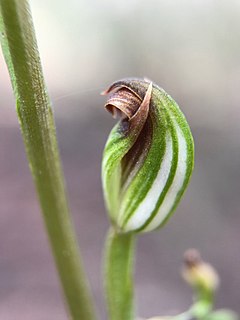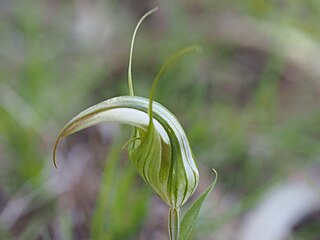
Pterostylis coccina, commonly known as the scarlet greenhood, is a species of orchid endemic to eastern Australia. As with similar greenhoods, the flowering plants differ from those which are not flowering. The non-flowering plants have a rosette of leaves flat on the ground but the flowering plants have a single flower with leaves on the flowering spike. In this species, the rosette leaves are relatively large and dark green, and the flowers are white, and bluish-green or red. It grows in New South Wales and north-eastern Victoria.

Pterostylis atrans, commonly known as the dark-tip greenhood or blunt-tongue greenhood, is a species of orchid endemic to south-eastern Australia. As with similar greenhoods, plants in flower differ from those that are not flowering. The non-flowering plants have a rosette of leaves flat on the ground, but the plants in flower have a single flower with leaves on the flowering spike. In this species, the flower is green and reddish brown with a protruding sinus and small club-like tips on the ends of the lateral sepals.

Pterostylis revoluta, commonly known as the autumn greenhood, is a species of orchid endemic to south-eastern Australia. As with similar greenhoods, the flowering plants differ from those which are not flowering. The non-flowering plants have a rosette of leaves flat on the ground but the flowering plants have a single flower with leaves on the flowering spike. This greenhood has white and green flowers which have a long, curved, pointed labellum which extends beyond the sinus between the lateral sepals.

Pterostylis ventricosa is a recently described and critically endangered species of orchid endemic to a small area of New South Wales. As with similar orchids, the flowering plants differ from those which are not flowering. The non-flowering plants have a rosette of leaves but the flowering plants lack a rosette at the base but have up to six tiny green, white and brown flowers.

Pterostylis multiflora, commonly known as the tall tiny greenhood, is a species of orchid endemic to south-eastern Australia. As with similar orchids, plants in flower differ from those that are not. Those not in flower have a rosette of leaves lying flat on the ground. Plants in flower lack a rosette but have up to twenty tiny green, white, and brown flowers in summer. The flowering stem has up to six stem leaves.

Pterostylis rubescens, commonly known as the blushing tiny greenhood, is a species of orchid endemic to south-eastern Australia. As with similar orchids, the flowering plants differ from those which are not flowering. The non-flowering plants have a rosette of leaves but the flowering plants lack a rosette at the base and have up to eighteen tiny green, white and brownish flowers.

Pterostylis amabilis is a species of orchid endemic to eastern Australia. As with similar orchids, the flowering plants differ from those which are not flowering. The non-flowering plants have a rosette of leaves but the flowering plants lack a rosette at the base but have up to ten tiny white and red to reddish-brown flowers. It is similar to P. parviflora but has larger rosette leaves and larger, more brightly coloured flowers.
Pterostylis aquilonia, commonly known as the northern cobra greenhood, is a species of orchid endemic to Queensland. As with similar orchids, the flowering plants differ from those which are not flowering. The non-flowering plants have a rosette of leaves but the flowering plants lack a rosette and have a single flower with leaves on the flowering spike. This greenhood has a relatively large green, white and reddish-brown self-pollinating flower.

Pterostylis sp. aff. alata is a species of orchid endemic to New South Wales but which has not yet been formally described. Non-flowering plants have a rosette of leaves but the flowering plants have a single flower with leaves on the flowering spike. This greenhood has a white flower with green markings and a brown-tipped dorsal sepal. It is only known from areas near Armidale where it grows near south-facing escarpments.
Pterostylis hians, commonly known as the opera house greenhood, is a species of orchid endemic to New South Wales. Non-flowering plants have a rosette of leaves flat on the ground but flowering plants have a single shiny white and green flower. This greenhood is only known from a single location near Ulladulla.
Pterostylis micromega, commonly known as the swamp greenhood, is a species of greenhood orchid endemic to New Zealand. Both flowering and non-flowering plants have a rosette of leaves while flowering plants also have a single, relatively large whitish flower with a pointed dorsal sepal. The flower colour and pointed dorsal sepal are unique in New Zealand Pterostylis.
Pterostylis psammophila, commonly known as the two-bristle greenhood, is a plant in the orchid family Orchidaceae and is endemic to South Australia. Both flowering and non-flowering plants have a rosette of leaves and flowering plants have translucent green and white flowers with an insect-like labellum, but the flowers are only open for a few days.
Pterostylis pulchella, commonly known as the waterfall greenhood, escarpment greenhood or pretty greenhood is a species of orchid endemic to New South Wales. As with similar greenhoods, the flowering plants differ from those that are not flowering. The non-flowering plants have a rosette of leaves flat on the ground but the flowering plants have a single flower with leaves on the flowering stem. This greenhood has a reddish-brown flower with a greenish-white base and protuding labellum with a cleft tip.

Pterostylis reflexa, commonly known as the dainty greenhood, is a species of orchid endemic to New South Wales. As with similar greenhoods, the flowering plants differ from those which are not flowering. The non-flowering plants have a rosette of leaves flat on the ground but the flowering plants have a single flower with leaves on the flowering stem. This greenhood has a relatively large white, green and light brown flower with a long, curved dorsal sepal and a protruding labellum.
Pterostylis russellii, commonly known as Russell's greenhood, is a species of orchid endemic to eastern Australia. Non-flowering plants have a rosette of leaves flat on the ground but flowering plants have a single shiny white and dark green flower on a flowering stem lacking a rosette but with a few spreading stem leaves.
Pterostylis sinuata, commonly known as the Northampton midget greenhood or western swan greenhood, is a species of orchid endemic to the south-west of Western Australia. Both flowering and non-flowering plants have a rosette of leaves lying flat on the ground and flowering plants have up to twenty yellowish-green flowers. It is only known from a small area between Northampton and Kalbarri.
Pterostylis tanypoda, commonly known as the swan greenhood, is a species of greenhood orchid endemic to New Zealand. Both flowering and non-flowering plants have a rosette of leaves lying flat on the ground and flowering plants have up to seven crowded, inconspicuous bluish-green and white-striped flowers.

Pterostylis torquata, commonly known as the collared greenhood, is a species of orchid endemic to New South Wales. As with similar greenhoods, the flowering plants differ from those which are not flowering. The non-flowering plants have a rosette of leaves flat on the ground but the flowering plants have a single flower with leaves on the flowering stem. This greenhood has a white flower with dark green and dark brown markings, although in some areas, the flowers lack the brown markings. The sinus between the lateral sepals is platform-like.
Pterostylis wapstrarum, commonly known as the fleshy greenhood, is a plant in the orchid family Orchidaceae and is endemic to Tasmania. Both flowering and non-flowering plants have a rosette of leaves lying flat on the ground and flowering plants have up to fifteen crowded green flowers with darker green veins.
Pterostylis rubiginosa is a species of orchid endemic to northeastern New South Wales. Flowering and non-flowering plants have a rosette of leaves that is withered by the time flowering occurs. Flowering plants have up to seven white flowers with rusty brown stripes, on a wiry flowering stem.


















